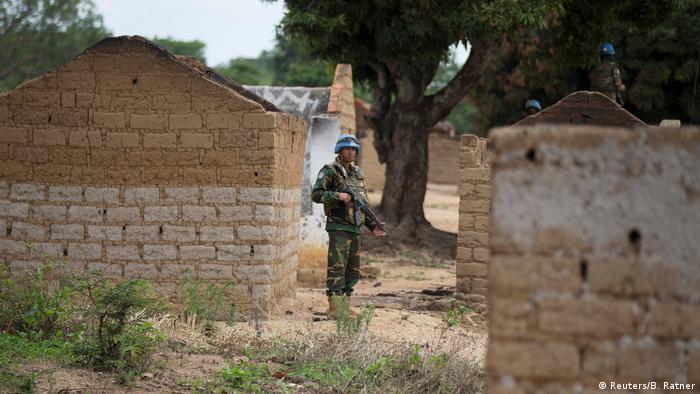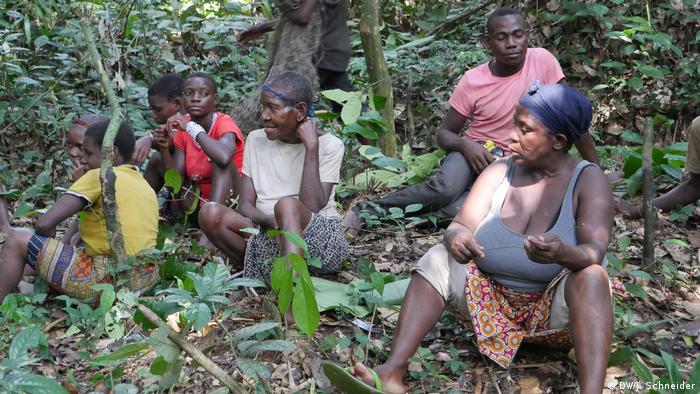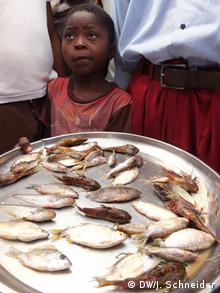The Central African Republic stands for war and Terror, much of the country is dominated by Warlords. And yet people are fighting for nature. A view in a torn country.
Watch the Video
00:51
Now live
00:51 Min.
“We are losing the war against the poachers”
If Luis Arranz comes out of his house, then he sees the plants on a green wall of trees and creepers. The heat is oppressive, the humidity is high. Here in the rain forest of the Congo basin, it is always humid and warm. Instead of seasons, there is just the exchange between little and a lot of rain.
You can run only in the daytime, because at night, the area belongs to the forest elephant. Thousands of lives here. They are rarely seen, because the colossi can move almost silently and invisibly between the giant trees of the jungle.
Watch the Video 01:31 live Now 01:31 Min. 
The forest elephants of Central Africa
Send Facebook Twitter google+ Tumblr VZ Mr. Wong Xing Newsvine Digg
Permalink https://p.dw.com/p/38G9V
The colossi of Dzanga Bai
Because of you, Arranz is here. In 1956, Spanish-born biologist looks back on 38 years of conservation work in Latin America and Africa, including many years in crisis and war – torn countries such as Chad and the Democratic Republic of the Congo. He has often been at the forefront of the fight against poaching. It is a dangerous Job. Arranz has already seen many of his Ranger by the bullets of poachers to die.
Without people like him, it would be Africa’s nature even worse. Now he works for the nature conservation organization World Wide Fund For Nature (WWF) as the Park Director of the Dzanga-Sangha reserve in the Central African Republic (ZAR). A country that could be, with its vast savannahs, rivers, and rain forest is a Paradise in the heart of Africa.
This natural Paradise is in danger. Poaching, deforestation, and especially since the years of raging civil war, destroy the country and its nature.

Arranz works in the small jungle town of Bayanga in the border area with Cameroon and the Republic of the Congo. Here on the edge of the chaos of War, the Dzanga-Sangha reserve-the only reserve in the country, which is still largely intact.
Together with the authorities to control and Arranz and his people to protect an area of more than 4000 square kilometers of rain forest.
To Watch: Luis Arranz: “The last elephants in the country are here.”
In particular, the great clearing of Dzanga Bai must be constantly monitored, because here, more than 150 elephants to keep drinking the mineral-containing water. A tempting target for poachers.
Although the war in the country does not take place in the protected area. Its effects are felt in the rain forest. In March 2013, professional poachers Dzanga Bai in the evening. 26 elephants were killed and their Tusks erupted. Since then, it has become somewhat calmer, however, the risk for animals and humans is enormous.
Video 00:32 watch live Now 00:32 Min. 
“Ivory faith purchaser, that only the elephant will die.”
Nature is in a war zone without weapons is hardly possible, says Arranz. During his years in the North-East of the Congo and in Chad, he has already many Rangers die in the fight against poachers. That is why it is important for him, his Ranger so equip that they have no answer to the assault rifles of the poachers somewhat. This money is to find but not so easy. The Ranger in Dzanga-Sangha is to be trained by military experts, plans Arranz.
On the shaded Veranda of his house in the rain forest, he explains his Problem: “Everyone is asking, why do you need weapons in order to protect elephants? But I’m not saying I need the weapons to protect elephants. I need the weapons to protect the people who protect the elephants. If you hit without weapons to poachers, then they die. A lot of people don’t understand or don’t want to understand it.”
To Watch: Luis Arranz: “I need the weapons to protect the people who protect the elephants.”

Peace in the Central African Republic, only in places where there are UN blue helmets – and even there, he is fragile
A country never came to rest
Peace in the Central African Republic is the exception. In Dzanga-Sangha, mainly by the armed presence of the UN blue helmets peace in the country. The rebels are deducted from the territory. Raids, looting and murder did not exist any longer.
The South West is the only Region of the country, in the it comes to outbreaks of violence. In view of the Situation in the Rest of the country is a small miracle.
The Region that is today the Central African Republic, was coined centuries before the Foundation of the state of violence and insecurity. In the 17th century. Century, attracted Portuguese and Dutch slave traders from the West into the country. You Arab traders followed coming from the North on the hunt for slaves.
Through the centuries of slave-hunting in the area until the 19th century. Century, largely depopulated. The Trauma has a lasting effect until today.
At the beginning of the 20th century. Century, the area was part of the French colony of French Equatorial Africa. The colonial government and private companies in the country is exploited for decades ruthlessly. This was especially true of ivory, Gold and precious woods. Uprisings were suppressed by the colonial power brutally.
In 1960, France dismissed the Central African Republic to independence. In the following decades, the rulers in quick succession, a military coup in the rule of her successor of the office changed.

The coronation of Jean-Bédel Bokassa to the Emperor at a cost of tens of millions of euros, while he let his people starve
The most dazzling figure was probably the officer of Jean-Bédel Bokassa who ruled from 1966 to 1979. He established a bloody regime of terror, which was tolerated by the former colonial masters France, because at the end of the sixties, the professional raw materials, began to promote diamonds and uranium.
Bokassa appointed in 1972 to the President for life and crowned himself at the 4. In December, 1977, to the Emperor of Central Africa. He leaned at his coronation at the coronation as Emperor of his idol, Napoleon Bonaparte, especially in terms of the pageantry. The equivalent of almost 20 million euros to the cost of the festivities, partially paid by the former colonial masters France.
While his people starved, verprasste Bokassa lives of millions for an expensive luxury. Anyone who protested, was cruelly murdered.
At the end of 1979, the Central African Emperor and ended the Empire abruptly with a coup, France the use of French paratroopers supported.

Even after his overthrow Bokassa was able to lead his luxurious life in French exile
Bokassa went into a luxurious exile in a castle in France, and was condemned on his return to Bangui in 1986, the first to death, then to life-long forced labour, then later pardoned. He died in 1996.
There are always new revolutions
Since the eighties of the last century, it came to the present again and again to new upheavals and armed conflicts in the country. Always handle the former colonial power France in the conflict. The had less humanitarian reasons, but secured French military bases in the country and the unhindered access to resources.
In 1997, France withdrew its troops and the UN blue helmet mission MINURCA began. You should mediate between rival groups and for stability and security. At the end of 1998, new elections were held, not calmed the Situation. Coup embossed attempts in the coming years. In several parts of the country, fighting broke out again and again.
In mid-2008, it seemed to finally give hope for peace. In June the government signed an overall peace agreement with several rebel groups in the country. The agreement, however, continued only a few months. The Chaos in the Tsar was even greater, since the conflicts in Sudan, Chad, and in East-assault of Uganda on the country.

Fighters of the Muslim Séléka popular 2012 fear and terror among the Christian population
Civil war
In 2012, the Muslim rebel Alliance Séléka from the North marched on the capital, Bangui. In March 2013, she occupied the capital and other important cities. This led to massive atrocities against the non-Muslim population. Rebel leader Michel Djotodia proclaimed himself head of state. As a defense against the Séléka Christian militias called Anti-Balaka formed. Both sides committed massacres of the different believers of the civil population and the public order in the country collapsed completely.
France decided then, once again, to intervene and sent in March 2013, troops to Bangui, and the situation calmed down a bit.
2014 UN, in turn, came blue helmets (MINUSCA) in the country. Currently, there are nearly 13,000 – especially from African States, as well as from Pakistan and Bangladesh. They are intended to protect the civilian population and the political reboot in the country to secure.
Watch the Video 01:03 Now live 01:03 Min. 
12.870 blue helmets to secure the peace
A transitional government came to Power. Between December 2015 and March 2016, a constitutional referendum, presidential and parliamentary elections were held. Faustin Archange Touadéra was President.
The hopes for a democratic and peaceful new beginning is not fulfilled, however. The new government has only in a small part of the country influence. Eighty percent of the country is dominated by more than a dozen armed groups and Warlords. The groups are fighting for influence and, above all, access to the mineral wealth of the country and terrorize the population.
Watch the Video 00:35 live Now 00:35 Min. 
“The children are traumatized highly”
Refugee misery
“The Situation in the whole of the Central African Republic is totally unpredictable… It will be unfortunately attacked, more and more people.” (Donaig de Lu, UNICEF)
Donaig de Lu has been working for years for the children’s charity of the United Nations (UNICEF) in the Central African Republic. You experienced first hand, that children especially under the ongoing Fighting, massacres and atrocities of suffering in the whole country. According to the UN-refugee aid (UNHCR) are currently more than 640,000 people refugees in their own country, so-called IDPs, Internally Displaced Persons. Almost as many are refugees in the neighbouring countries. About half the refugees are children, in the refugee camp of Kaga Bandoro in the North-West of the country.
The consequences are dramatic. According to UNICEF, more than 100 million children do not go in the world because of Wars and conflicts to school. In addition to Niger and Mali, the Central African Republic is the worst place to be a child. Educational opportunities there are as good as any.
Video 01:26 live Now 01:26 Min. 
Achilles everyday life in the refugee camp
Watching: the lives of the children in the refugee camp of Kaga Bandoro
The government in Bangui has neither the Power nor the means to improve the Situation for the people in the country. Much less is true for the preservation of nature.
However, despite the Chaos in the Central African Republic there are people who work for the preservation of the forests. Particularly the ethnic groups of BaAka and Sangha-Sangha, living for thousands of years in the rain forest and its rivers. The forest dies, its culture dies. So, in a sense, the forest guardians, who take care of together with Arranz and his Team, to the receipt of the last peaceful natural Paradise in the Central African Republic.

The BaAka are one of the oldest peoples of the world
The forgotten forest folk
No one knows the forest as well as the indigenous peoples here. You are the first to know when Strangers are in the forest on the road and can warn the Ranger.

In the nets of the fishermen only have small fish caught almost
But the plunder of the forests and the ongoing discrimination of the BaAka by the majority population of the Bantu ethnic groups threaten their culture. You were already in more peaceful times, more always on the fringes of society, it became the civil war’s only going to get worse. AIDS does not come at you.
BaAka have originally lived semi-nomadically in the great forests of the Congo basin as hunters and gatherers. However, many forest areas are swept by poaching literally empty. Outside of the protected areas in the Congo basin, the phenomenon of the “Empty Forest syndrome spreads”. That is, there are hardly any wild animals in the rain forest. In addition, many rivers are overfished.
To come nevertheless, of food fish, many people with mosquito nets. Then a fish to be caught eggs and young animals. Whole fish populations to collapse, with dramatic consequences for the nutritional situation.

Posters to clarify the BaAka and Sangha-Sangha about their rights
Human rights
The breakdown of the own culture of the indigenous peoples of the country a little, especially since it is difficult for them to find a place in modern society. You will not only learn the discrimination in access to education, human and civil rights are granted by the state and the majority population of the Bantu conditionally.
Watch the Video 01:52 live Now 01:52 Min. 
“I fight for the rights of the BaAka”
“The BaAka do not know their rights. That’s why I’m here.” (Martial Yvon Amolet, Lawyer)
Martial Yvon Amolet has his office in Bayanga and takes care of the rights of the Indigenous of the area. Whenever these have for their origin the problems, you can contact him. It is often everyday things, but also to violence against members of the BaAka minority. Is financed, the lawyer with the WWF’s money. The government in Bangui has no means and no interest in it. It is no different with medical care.
Watch the Video 01:11 live Now 01:11 Min. 
Central African Republic: rain forest clinic
Send Facebook Twitter google+ Tumblr VZ Mr. Wong Xing Newsvine Digg
Permalink https://p.dw.com/p/37yBY
The Rain Forest Clinic
Health crisis
Health is a human is also right and just medical care to the people deep in the rain forest is difficult. Hospitals that can afford them and easy to reach.
“Discrimination of the BaAka and Sangha-Sangha means that there is virtually no medical care.” (Emilia Bylicka, Doctor)
The BaAka and Sangha-Sangha, suffering from malnutrition, the child mortality is high, mainly because of the rampant Malaria. In addition, many children suffer from parasitic infestations. Tuberculosis claims many human lives. In the jungle village of Monasao the only clinic is far and wide. Their employees are often days at a time, in order to reach patients in remote jungle villages.
Nevertheless, many children still die before the age of five.
Glimmer of hope for the country
Activists of the BaAka and Sangha-Sangha have jointly founded with the WWF in the last few years a forest school. You should bring the youth of the peoples ‘ own traditional way of life. The group turns Videos about her life, makes plays and is now networked across the border to Cameroon to the local indigenous people.
Watch the Video 01:22 live Now 01:22 Min. 
Forest school: Knowledge and traditions
It takes a lot of courage in a war-torn country like Central African Republic, for those who are not heard, be it people or animals or the forest itself. Thanks to Martial Yvon Amolet, Emilia Bylicka and Luis Arranz, there is hope that the BaAka continue to be Knowledge a distinct people with a rich traditional and elephants in the future on the Dzanga Bai.
Watch the Video 00:53 live Now 00:53 Min. 
The spirit of the rain forest, to summon, to protect him